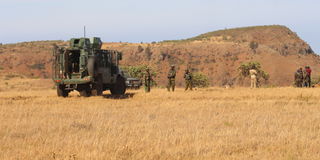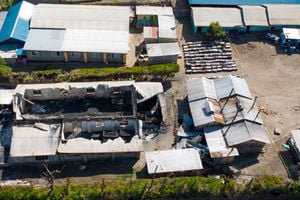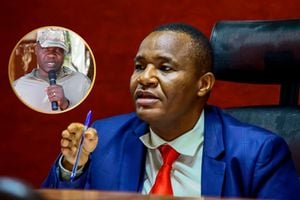Why bandits roaming Rift Valley defy interventions

Security troops readying for an operation to flush out armed bandits from Malaso escarpments in Samburu.
In the early days of his administration, President William Ruto posted on his X (then Twitter) handle: “After receiving a comprehensive report on the Turkana/Pokot incident that led to 10 security/administration officers losing their lives, I have instructed security agencies to deal firmly, decisively and conclusively with those involved. Cattle rustling will stop na sio tafadhali [I’m not pleading].”
This was a relief to Kenyans, particularly North Rift residents grappling with the vice of armed violence manifesting itself as cattle rustling and banditry.
Soon, “Operation Maliza Uhalifu”, a multi-agency security operation, was deployed to pacify the region. Initially, it seemed to be winning the hearts and minds of the residents as the number of armed violence incidents reduced. But it seems that the early successes have been eroded—as evidenced by the recent increased killings, loss of property and closure of some learning institutions that had been reopened. The good news is, the government has announced plans to roll out security measures to finally defeat the bandits.
However, it would be prudent for the government to review its ongoing efforts to pacify the region alongside the Upper Eastern region. Peace barazas have been held, political leaders summoned, interrogated or detained or extrajudicially killed, meetings with professionals from the affected communities held, cattle rustlers or bandits labelled as “terrorists” but the murderers are growing in confidence and impunity.
One, it was a policy mistake to disarm National Police Reservists (NPRs) from one of the communities on claims that they were the aggressors and so did not deserve them. Two, enforcement of informal ceasefire or peace agreements has been the Achilles’ heel in the region. Dialogue comes up with a sort of oft-ignored peace accord. NPRs stand a better chance in helping their implementation and enforcement.
Three, accountability within the security architecture in the region is limited. Our security forces have largely succeeded in confining Al-Shabaab (who are more heavily armed than the bandits) to the border with Somalia and neutralised Sabaot Land Defence Force (SLDF). Our police officers are headed to Haiti to cage dangerous armed gangs that the Americans couldn’t. Why can’t they contain ragtag bandits armed with ageing AK-47 rifles? I once asked a security officer in Laikipia why they are failing and he said they have not been “allowed to work”. That they got ‘orders from above’ to go slow on the criminals. We must facilitate, support and then demand more from the agencies.
Four, the residents and political leaders of the areas reeling from insecurity blamed on decades of economic marginalisation should contend with the reality that the government may not have the resources to address the challenge. Everybody knows what needs to be done but, with the public debt piling, the government is struggling financially. Lastly, a roundtable with administration and security veterans of these regions could also unlock new working strategies.
It seems the modus operandi of the bandits is disorientation—which scholars describe as acts to alienate the government from the citizens, reducing it to impotence in the eyes of the population, to be perceived as unable to cope with the evolving chaos. That is why a cross-section of leaders have publicly vouched for their communities to make their own security arrangements as formal security is inadequate or inefficient.
Mr Pkalya is a peace and conflict researcher and co-author of ‘Conflict in Northern Kenya: A Focus on Internally Displaced Conflict Victims’. [email protected].





